Serving 1,215 students in grades 9-12, Pell City High School ranks in the bottom 50% of all schools in Alabama for overall test scores (math proficiency is bottom 50%, and reading proficiency is bottom 50%).
The percentage of students achieving proficiency in math is 21% (which is lower than the Alabama state average of 29%). The percentage of students achieving proficiency in reading/language arts is 27% (which is lower than the Alabama state average of 47%).
The student:teacher ratio of 18:1 is higher than the Alabama state level of 17:1.
Minority enrollment is 22% of the student body (majority Black), which is lower than the Alabama state average of 49% (majority Black).
Quick Stats (2025)
- Grades: 9-12
- Enrollment: 1,215 students
- Student:Teacher Ratio: 18:1
- Minority Enrollment: 22%
- Graduation Rate: 82% (Btm 50% in AL)
- Overall Testing Rank: Bottom 50%
- Math Proficiency: 21% (Btm 50%)
- Reading Proficiency: 27% (Btm 50%)
- Science Proficiency: 28% (Btm 50%)
- Source: National Center for Education Statistics (NCES), AL Dept. of Education
School Overview
Pell City High School's student population of 1,215 students has grown by 5% over five school years.
The teacher population of 68 teachers has grown by 7% over five school years.
Grades Offered
Grades 9-12
Total Students
1,215 students
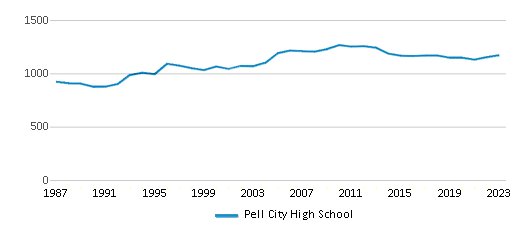
Gender %
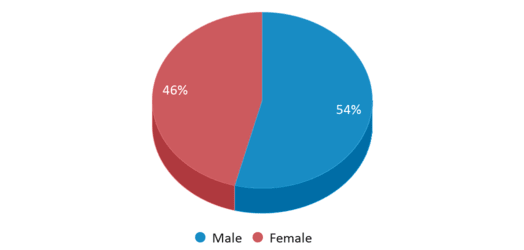
Total Classroom Teachers
68 teachers
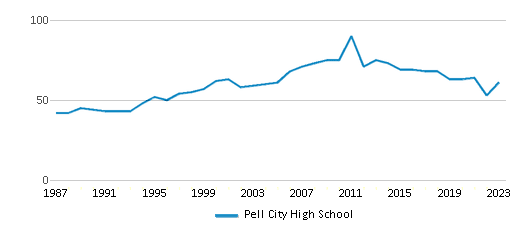
Students by Grade
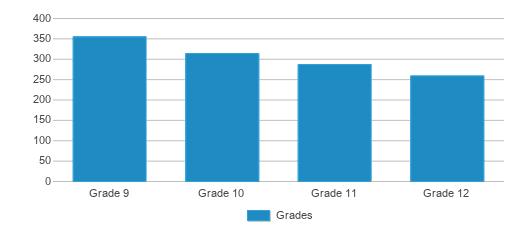
School Rankings
Pell City High School ranks within the bottom 50% of all 1,285 schools in Alabama (based off of combined math and reading proficiency testing data).
The diversity score of Pell City High School is 0.37, which is less than the diversity score at state average of 0.63. The school's diversity has stayed relatively flat over five school years.
Overall Testing Rank
#816 out of 1285 schools
(Bottom 50%)
(Bottom 50%)
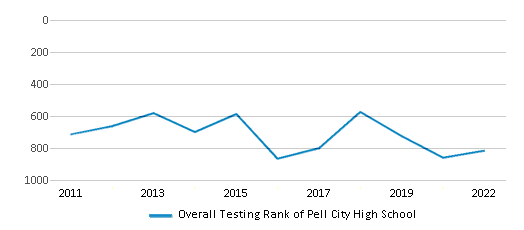
Math Test Scores (% Proficient)
21%
29%
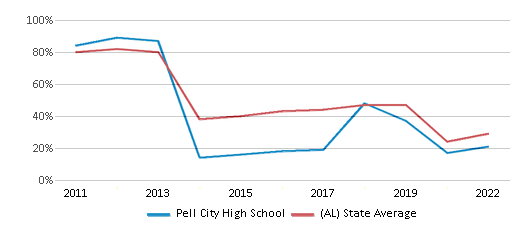
Reading/Language Arts Test Scores (% Proficient)
27%
47%

Science Test Scores (% Proficient)
28%
38%
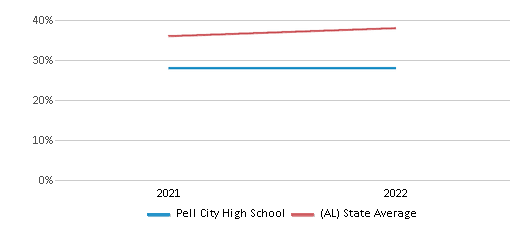
Student : Teacher Ratio
18:1
17:1
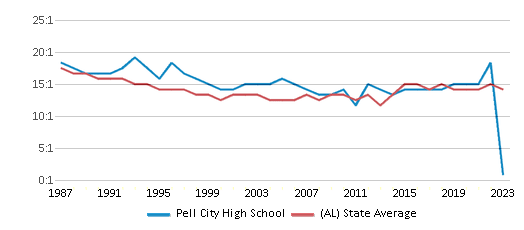
American Indian
n/a
1%
Asian
1%
1%
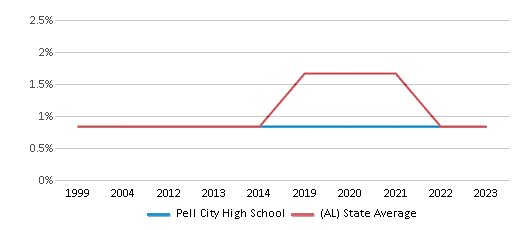
Hispanic
4%
11%
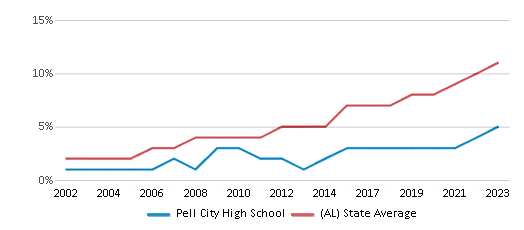
Black
15%
32%
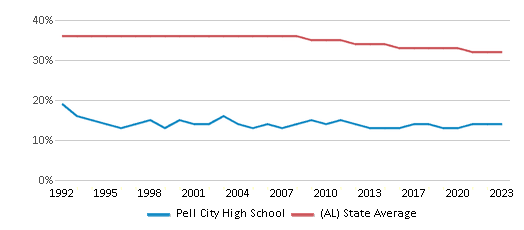
White
78%
51%
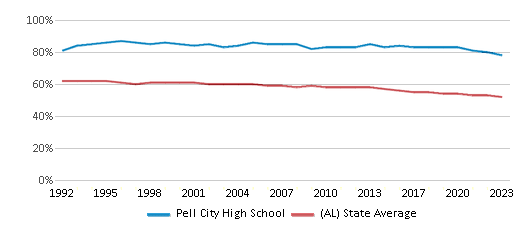
Hawaiian
n/a
n/a
Two or more races
2%
4%
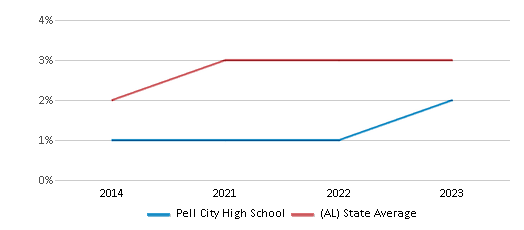
All Ethnic Groups
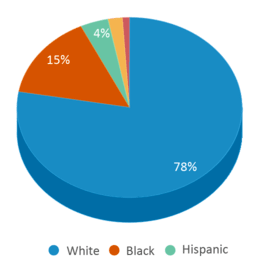
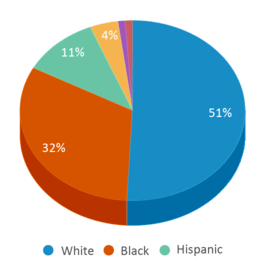
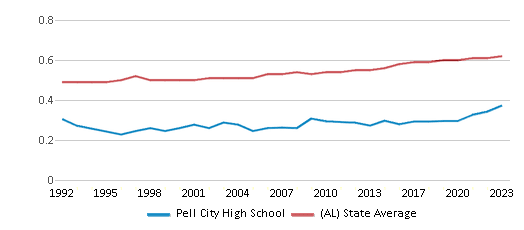
Graduation Rate
82%
88%

Participates in the National School Lunch Program (NSLP)
Yes
Eligible for Free Lunch
53%
56%
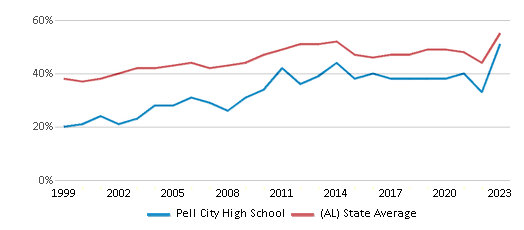
Eligible for Reduced Lunch
4%
5%
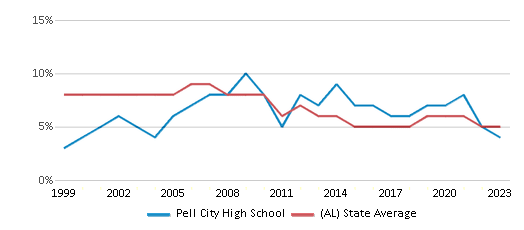
School Statewide Testing
School District Name
Source: National Center for Education Statistics (NCES), AL Dept. of Education
School Notes
- Pell City High School is the only high school serving the Pell City School system.
- The school offers an advanced diploma track that allows students to take honors classes in math, and the sciences, and honors or AP classes in english, and history. The school also offers an excellent gifted program. Generally however the school is not considered on par academically with some of the larger Birmingham area schools such as Hoover High School and Mountain Brook High School.
- Sports: The Pell City School colors are black and Gold and their mascot is the Panthers. The Panthers participate in 6A level sports and are one of the smallest schools in the Division. Despite this their football team has continually advanced to the playoffs since 2003 under the leadership of head coach and athletic director Jay Brown. The Panthers also field teams in; men's and woman's Soccer, and Basketball, Baseball, and Softball, Men's Golf, and Woman's Volleyball. Their band is a top rated performer. The "Marching Band of Gold" regularly competes on the state band circuit and regulary bring home honors. Finally they field several academic teams including Scholars Bowl and Math Team.
- Clubs: Pell City High School offers many after and during school clubs. Year book and the school newspaper called the "Panther Paw" are two popular one. In addition the School offers National Beta Club, Key Club, S.A.D.D (Students against Destructive Decisions) and many more.
Profile last updated: 02/09/2025
Frequently Asked Questions
What is Pell City High School's ranking?
Pell City High School is ranked #816 out of 1,285 schools, which ranks it among the bottom 50% of public schools in Alabama.
What schools are Pell City High School often compared to?
Pell City High Schoolis often viewed alongside schools like Saint Clair County High School, Springville High School, Moody High School by visitors of our site.
What percent of students have achieved state testing proficiency in math and reading?
21% of students have achieved math proficiency (compared to the 29% AL state average), while 27% of students have achieved reading proficiency (compared to the 47% AL state average).
What is the graduation rate of Pell City High School?
The graduation rate of Pell City High School is 82%, which is lower than the Alabama state average of 88%.
How many students attend Pell City High School?
1,215 students attend Pell City High School.
What is the racial composition of the student body?
78% of Pell City High School students are White, 15% of students are Black, 4% of students are Hispanic, 2% of students are Two or more races, and 1% of students are Asian.
What is the student:teacher ratio of Pell City High School?
Pell City High School has a student ration of 18:1, which is higher than the Alabama state average of 17:1.
What grades does Pell City High School offer ?
Pell City High School offers enrollment in grades 9-12
What school district is Pell City High School part of?
Pell City High School is part of Pell City School District.
School Reviews
3 6/30/2018
It`s okay for student life. Needs Academic help
2 5/16/2011
I have seen large numbers of students wo can not read, write, or do simple math. Poor disapline and many teacher, student inapropriate behavior.
Review Pell City High School. Reviews should be a few sentences in length. Please include any comments on:
- Quality of academic programs, teachers, and facilities
- Availability of music, art, sports and other extracurricular activities
Recent Articles

What Is A Charter School?
Explore the world of charter schools in this comprehensive guide. Learn about their history, how they operate, and the pros and cons of this educational innovation. Discover key facts about charter schools, including admission policies, demographics, and funding, as well as what to look for when considering a charter school for your child.

10 Reasons Why High School Sports Benefit Students
Discover the 10 compelling reasons why high school sports are beneficial for students. This comprehensive article explores how athletics enhance academic performance, foster personal growth, and develop crucial life skills. From improved fitness and time management to leadership development and community representation, learn why participating in high school sports can be a game-changer for students' overall success and well-being.

February 05, 2025
Understanding the U.S. Department of Education: Structure, Impact, and EvolutionWe explore how the Department of Education shapes American education, from its cabinet-level leadership to its impact on millions of students, written for general audiences seeking clarity on this vital institution.









